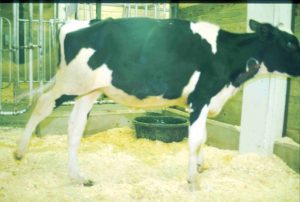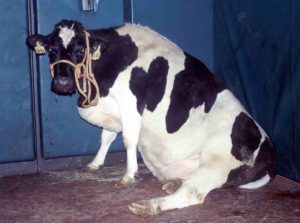Bovine musculoskeletal disorders
Neuromuscular conditions
Spastic paresis (Elso Heel)

This is a genetic, multifactorial condition seen primarily in Angus and Holsteins. It is primarily contraction of the gastrocnemius muscle. The gait change starts with very straight leg, then the animal can’t bring leg forward, and, finally, the leg is held behind. It is accompanied by a raised tail head (looks like tetanus and shivers).
Goal of therapy (tenectomy and/or neurectomy) is to get to slaughter rather than to maintain in herd.
Spastic syndrome (Stable Cramps)
Muscle contractions or spasms of the hindlimbs. This can progress to hindlimb paresis or paralysis. Considered a genetic disease.
Femoral/obturator paresis
This is often related to parturition or falling with legs back . Treat with floating in water (float tank), NSAIDs, lifting with hip lifters or a sling.
Cattle can get this with hip lock dystocias.

Neonatal calves can get femoral nerve paresis. These look like patellar luxations but are due to problems with quadriceps function. These are congenital lesions and often bilateral lateral luxations. And, as the patellar doesn’t move correctly the groove doesn’t form properly. Calves will have a crouched stance. Poor prognosis if no return of nerve function.
Radial/brachial plexus injury
Damage to the nerve occurs with humeral fractures, rapid abduction (fall on ice), or being recumbent without padding. Treat with supportive care, splinting, NSAIDs, padding and floating. A splint is placed down the back of the limb to help fix the triceps.

